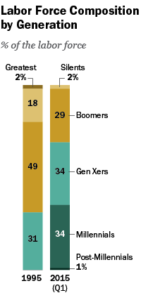Inter-Generational Leadership and the Art of Translation
RESOURCE LIBRARY

Did you know that today’s workforce is nearly evenly split between Boomers, Gen Xers, and Millennials? According to recent Pew research, the current blend of generations in the U.S. labor force is about 29%, 34%, and 34% respectively. While this makes it a very exciting time to be a leader, it also creates a substantial climate of challenge, specifically at the intersection points between generations. And what are some of those challenges? See if you can relate:
 Values: Each generation assumes a certain set of broad cultural values and expectations about what’s important in life (Ex: creativity vs. frugality).
Values: Each generation assumes a certain set of broad cultural values and expectations about what’s important in life (Ex: creativity vs. frugality).
Technology: While Millennials assume the use of technology and consider it part of the fabric of their daily routines, Boomers and Xers can have widely varying assumptions about how technology should function in the workplace.
Communication: There can be varying baselines across generations when it comes to formality, medium, and style of workplace communications.
None of these examples are unmanageable in isolation, but combine them all together and amplify the points of friction in a fast-paced workplace, and you can see how difficult it can be to manage three generations in the workforce at the same. The rules are changing. And the pace is quick. So is there a secret to getting it right? Yes.
Great leaders can flourish in the inter-generational workplace if they are fluent in the art of translation.
In order to thrive in a workplace of differing values, leaders must create a culture of translation; a place where big picture concepts can be decoded out of each generation’s dialect and portrayed on a large scale that the entire enterprise can get behind. This means that great leaders must understand three primary aspects of each generation when it comes to values, technology, and communication:
Assumptions • Motivators • Form/Function
By coming at each challenge from this perspective, leaders can unearth what really matters to each generation, cut through the forms to get to the functions, and identify what the assumptions are that need to be identified or explained. In other words, translate the big concepts to find common ground.
A great leader is a great listener is a great translator. Are you looking for one?
